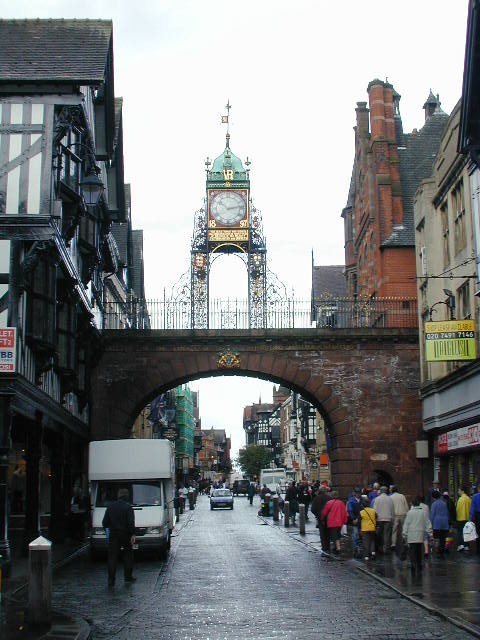
I apologize for posting this report a day late; this was a busy day, and we got back to the hotel near midnight, so I just retrieved and sent emails and went to bed, leaving the webpage for the next day.

We were staying in a Welsh town that was very close to the border with England, and today the first thing we did was get on the buses and cross back into England to visit the walled city of Chester. This town was a major Roman garrison called Deva in the first century AD, with a wall around it to protect the headquarters of three legions. The Romans also left an amphitheatre that has been partially excavated; the Normans left a castle, much of which was replaced with Neoclassical architecture in the 19th century; and the residents in the Middle Ages left quite a few buildings that are still standing and in good repair. The major point of interest, though, is the walls, which are among the best preserved medieval city walls in Britain. The old defensive gates were mostly replaced with decorative ones in the 19th century; the picture shows the Eastgate, with a clock built above it in 1897 to commemorate Queen Victoria's Diamond Jubilee, the 60th year of her reign.
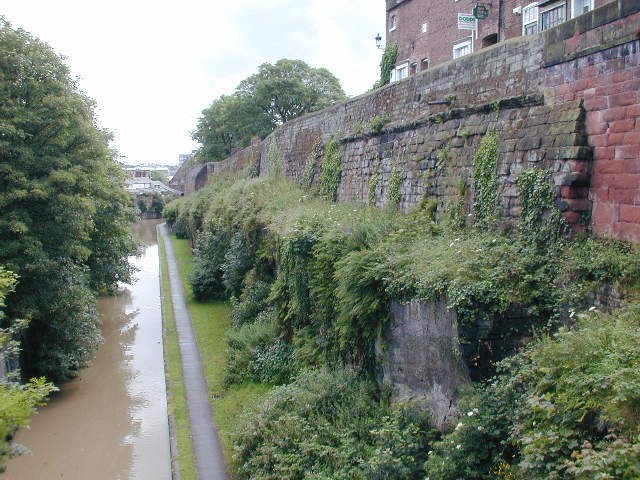
Here is a good example of the well-preserved city wall, near the Northgate. The Roman wall, of heavier stones, extends about up to the protruding cornice, and the medieval additions are above and around this. The Romans dug a defensive trench outside the wall; it has been replaced by a canal. Near here is yet another structure named the "Bridge of Sighs"; the reason for the name here is that this is a footbridge between a prison and a hospital across the canal. Condemned prisoners used to walk across it to receive Last Rites in the hospital chapel, then back across it to their execution.
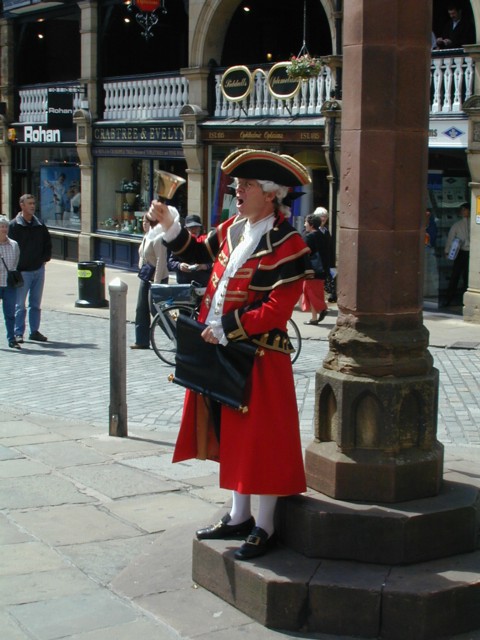
We were told to come back to The Cross, at the major intersection of streets next to the Town Hall, at 11:55 a.m. for a surprise. This turned out to be the Town Crier, who after the Town Hall bell rang at noon greeted us and several other groups of visitors by name! He also greeted foreign visitors from various countries in their own languages: "A warm welcome to you in our historic city!" in German, French, Japanese, and Dutch. He had to "wing it" for others; he said he was still learning the American language, but he thought the best way to translate his greeting was "Hi!" After saluting a Welsh visitor in (as far as we could tell) fluent Welsh, he added in English "...and be sure to be outside the city walls by sunset," so I guess things are a little tense along the frontier! Finally, he invited us to sing, so we performed "Cantate Domino."
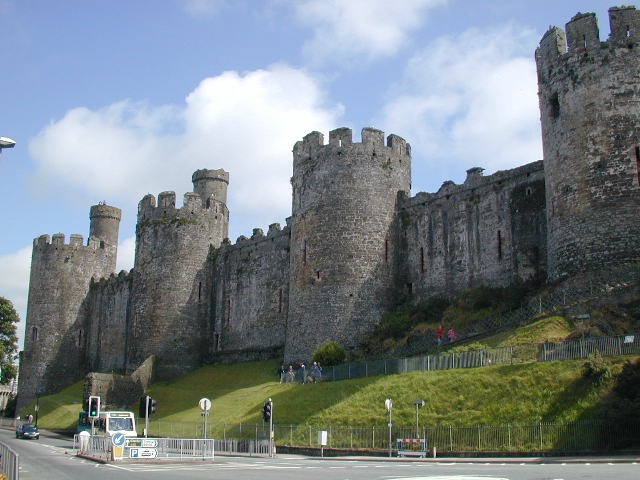
Of course, the Chester Town Crier was joking by referring back to events in the region about 700 years ago, when Edward I built an "iron ring" of 17 castles to keep his thumb on the Welsh after they rebelled twice in the late 13th century. After leaving Chester we went to visit one of these: Conwy Castle, in the town of the same name. The castle is in remarkably good condition, as is the city wall built at the same time, and visitors are allowed into nearly all parts of it.
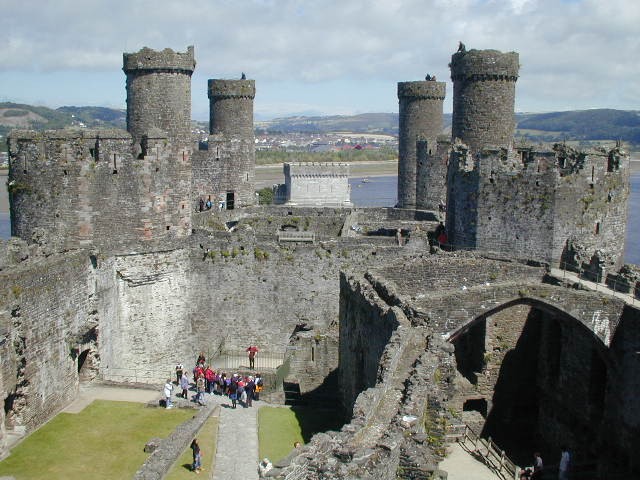
Here is a view inside the castle, from the top of one of the main towers that you can see in the previous photo. The grassy area to the left is the Outer Ward, and the arch at right once supported a roof over the Great Hall. Quite a few MBCC folks climbed the four tall, narrow towers visible here, but my acrophobia cut in on me before I tried! The more modern-looking squarish "castle" in the background is a railway bridge, built in the 19th century and still in use; there's also a one-lane suspension bridge that used to be the only way into town, to the left out of sight behind the towers, and a modern automobile bridge built to relieve the bottleneck.
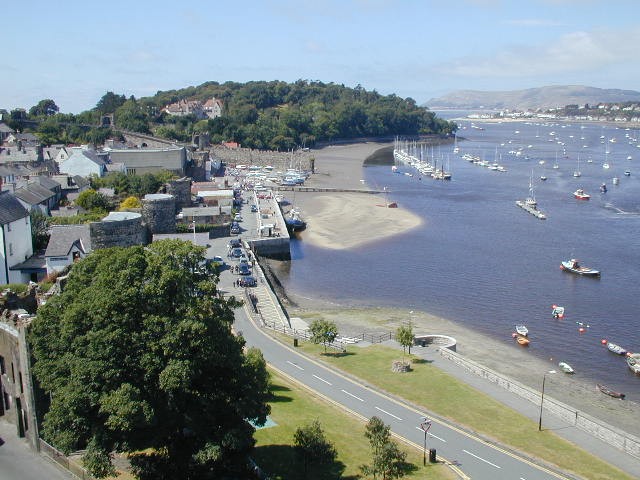
Here you can see part of the town of Conwy, with the far side of the wall visible in the distance and fortifications running right along the shore, to prevent attack from the Conwy Estuary and to protect the royal court when they arrived by boat. King Edward I must be spinning in his grave; while one flag above the castle carried what I think is his monogram (a cross with an incomplete circle, like a "C", behind the arms), the other flag was that of his old enemy, Wales!
On a totally unrelated subject, we had seen a sign in Hay-on-Wye the previous day that advertised "coarse fishing." We wondered what the heck that was, and today in the information center for Conwy Castle among brochures for regional tourist attractions I saw the term again, so I asked. "Coarse fishing" is what fly fishermen call fishing with bait! I guess they regard fly fishing as truly "fine" fishing: "Use bait? I'd as soon shoot the fox instead of letting the dogs catch him!"
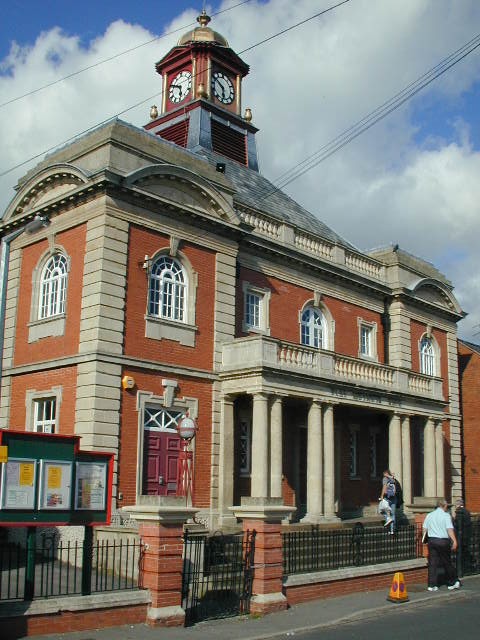
Finally we went to the town of Rhosllanerchrugog, not surprisingly shortened by the locals to "Rhos," for a formal evening concert at the STIWT Theatre. This used to be the site of a Miners' Institute, an educational and mutual-benefit organization paid for by the area's miners, who gave 2 pence per week each to build and run it. Rhos, according to our own David Evans, has produced more great singers, instrumentalists, composers, arrangers, etc., for its size than anywhere else on earth; the place lives and breathes music, in its schools, churches, and family traditions. When the mines closed and the Institute, or 'Stiwt, was shut down, it was converted into a musical performance hall. The Rhos Male Voice Choir, whose home theatre this is, visited Southern California in 1986; some members stayed with the Evans family, and they have kept in touch, so when we decided to visit Wales a concert here was arranged.
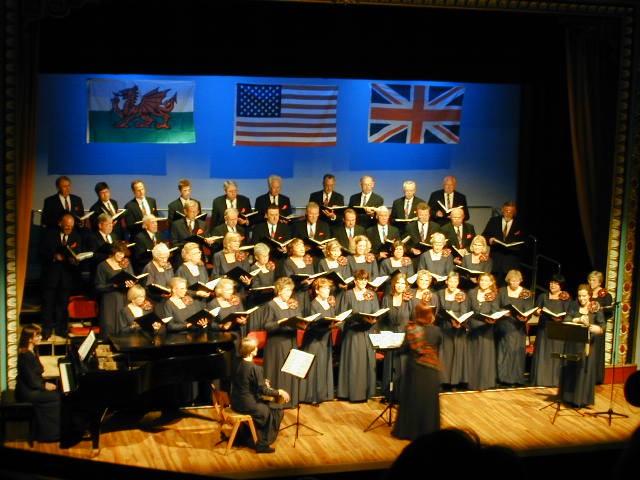
Here we are, singing most of the songs in our repertoire during a two-hour formal concert with intermission. Music can be incredibly competitive at the level practiced in Rhos, but as David emphasized before the concert as he told the story of how we came to be in town, we weren't there to compete, but to entertain; and I think we were pretty successful.
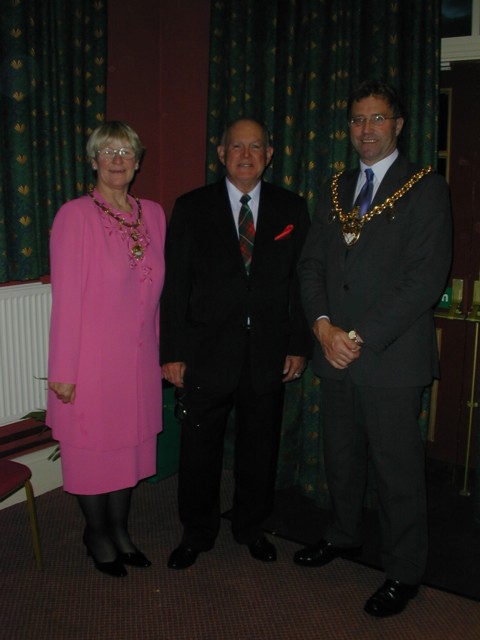
After the concert a large buffet reception was held, and several local dignitaries were in attendance. Here is David with the Mayor and Mayoress, Rod Skell and Pat Williams. Others present included the Council Directors, Hilary and Mike Wooley, and the former conductor and accompanist of the Rhos Male Voice Choir, John Tudor Davies, MBE, who arranged our concert here. (I took a couple of photos with all of these, and Pat Edwards, David, and Guy Hatlie, but both came out very blurry--I'm sorry!) We had to tear ourselves away at the end, as some members of the Rhos choir who were present began to sing and we really wanted to listen, or join in for songs we knew. Before the tour, David had told us many things about Wales and Rhos, and we have found that all of them are true! It was an honor to visit and perform here.
 To
Thursday, 4 July 2002
To
Thursday, 4 July 2002 Back
to choir tour itinerary
Back
to choir tour itinerarynew 4 July 2002, revised 21 July 2002